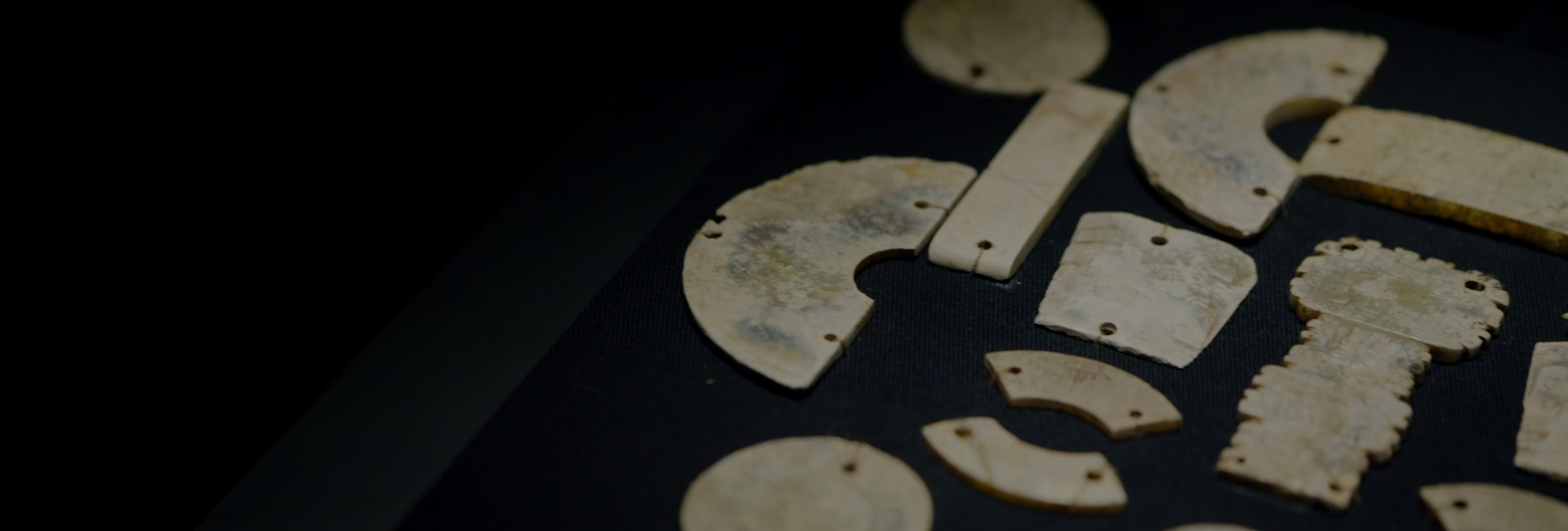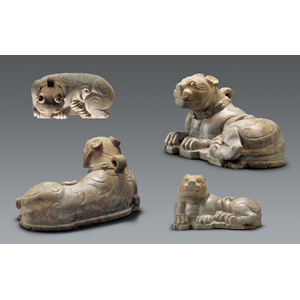

Xuzhou Han Culture Academic
Submit
【XU BO】Maximum daily capacity: 10,000 person-times Instantaneous capacity: 2,500 person-times


◇ Heritage No. :
◇ Collection Name:Stone Panther
◇ Historical date:West Han dynasty
◇ Collection Size:Length: 23.5 cm Width: 13 cm Height: 14.5 cm
◇ Collection Source:Excavated from the Tomb of the King of Chu in 1994
Excavated from the No.1 chamber in the west of the tomb, Stone Panther is made from slim gray marble. Integrated with the pedestal, the panther are lying on the pedestal with their eyes open and staring. His mouth was slightly open, teeth were exposed, ears were straight up, face was ringed with iguana hair, and the neck was adorned with an ornate cockle collar with knobs for fastening ropes. The body is fat, the long tail from two hind legs are curl on its back, and four feet cleverly put on the same side, which looks less wild but strong and docile. Stone panther uses round carving techniques, which is concise, clear and vivid. The chamber also unearthed another stone panther of the same shape and size, but the body has obvious defects. The same tomb also unearthed 2 pieces of cooper panthers with the similar shape. These panther are used for flattening mat.
Panther was a common image in the tombs of West Han dynasty. The tomb of Liuyi at Bojishan (Xuzhou) can date back to the early West Han dynasty, the decorative patterns on the back of the figure paintings mirror have some scene of training panther. The trainer is a man in a Han suit, seated, holding out his left hand to stroke the head of a panther. The leopard is slender in shape, with circle pattern on its body, its front paws on the ground and its back body in the air. The tomb of Han dynasty (M168) at Fenghuang mountain in Jiangling could date back to the early West Han dynasty. The lacquer flat pot unearthed from the tomb was painted with seven leaping panthers, and all with collars around their necks. The tomb of Dowan in Hebei province, dates back to the middle of West Han dynasty and four bronze panthers were unearthed. The panthers' eyes were inlaid with white agates, which turned into red because of the adhesive. Bronze panthers with swirls of gold wires were unearthed in Cangzhou. The bronze panther unearthed in West Han dynasty tomb (GMl87) in Shuo county, Shanxi Province, is very similar to the one unearthed from the tomb of king of Chu at Shizishan. An adult male leopard was buried in the tomb of Liujin, the king of Guangyang qing. Liu jian died in the fourth year of Yuan emperor period (45 BC). The tomb dates back to the late West Han dynasty. The above evidence shows that during the West Han dynasty, emperors and nobles had the custom of domesticating leopards. The picture of leopard training on the unearthed objects and the collar on the leopard's neck also clearly indicate that Chinese have domesticated leopards in the early West Han dynasty, and may be realized in local place. The domestication of panthers started from king Shak of Peacock dynasty in India, which was equivalent to the period of Spring and Autumn and Warring States period in China. At present, China has not found any physical information about the domestication of leopards before West Han dynasty. During West Han dynasty, these domesticated leopards were used to assist in hunting. With their fast running speed and good hunting ability, they were the right assistants in hunting. This also reflects the prevalence of hunting custom at that time.
For a long period after Han dynasty, panthers were rarely seen in archaeological excavations and documents for hunting. From Tang dynasty, we can find some information about it again. The tomb of Zhanghuai prince, Li xian, (654-684 AD) is one of the main accompanying tombs of emperor Gaozong and empress Wu zetian. The eastern wall of the tomb is painted with a spectacular Hunting Trip Map. The painting is over 2.4 meters high and 12 meters in length. It is painted with more than 50 groups of saddle horse figures with eagle dogs and arrows at the waist and one of the riders had a spotted leopard squatting behind him. The mural painting of prince Yide's tomb shows a picture of taming a leopard. Yide prince, Li Chongrun, whose name used to be Li Chongzhao, was the eldest son of emperor Zhongzong of Tang dynasty. In the first year of Dazu (AD 701), he was executed by Wu zetian. The picture of taming a leopard is located on the east and west sides of the first passage hole. In the picture, four male servants hold a long staff with a round head and lead a leopard with one hand. Among them, 2 people have an image of Hu ethnic with deep eyes, high nose and beard. In addition, the main tomb of Tangjinxiang county in the eastern suburbs of Xi 'an unearthed 6 terracotta warriors and horses for hunting, one of which had a panther on its back. Thus it can be seen that hunting was extremely popular in the prosperous Tang dynasty, and the panther used for hunting was also quite common. Among the servants engaged in taming panthers, quite a few were western barbarians. After Tang dynasty, the practice of hunting with panthers continued until Yuan and Ming dynasties.